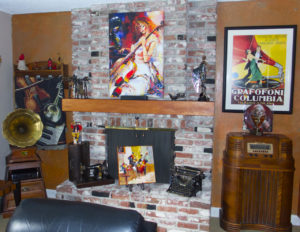
We spent what a little over half of 2017 adding an addition to our house. While I was determined to do everything possible to keep the addition from affecting the sound in my listening room, as it turned out, it wasn’t possible. The picture above is how my room looked before the addition. (If you don’t want to read about this journey, you can skip down to paragraph four to read the meat of this article.) It took over 6 months to get a building permit in our city, and to get the plans approved we had to have a door that connected the listening room to the new addition. This door had to be in the corner to the right and behind my listening chair. We temporarily left the door as an open passageway between the two areas of the house. Then my son and I came up with a design for a rolling bookcase to function like a barn door. This would look great, and what’s not to like about a secret door that is disguised as a bookcase.
Remodeling and My Listening Room
One of the results of the new addition is that my listening room no longer gets much natural light. The sliding glass doors that formerly opened to a patio now open on a walkway that leads to a one-story building. So, I decided to call an electrician and install some recessed lighting. The first thing I explained to the electrician was that none of the work could in anyway be tied into my dedicated line for the audio system. They also promised they would send out their sheetrock guys to patch any holes they had to put in the ceiling for the lights.
With the new lights installed, I was ecstatic because I now have lights over the turntable and I could quit wearing a miner’s light on my head when setting up the turntable, rewiring the system or when changing things for a piece that has come in to review. There was just one problem with the new lighting. Now, even I had to admit that the old sisal carpet had not held up well and needed to be replaced. So the flooring guys came over, and we decided to go with a better wearing carpet that is plusher and has a heavier pad.
Applying sheetrock and laying carpet in a room without damaging my system was a big concern. So, I had a plan; I would set it up so that the sheetrock guys would come out on Wednesday to patch the ceiling and then on Friday, the carpet people would come out. This way I could move everything out of the room on Tuesday evening and by Friday afternoon I’d be back in the room. This almost worked, but I had to add a couple of days because after removing the ‘popcorn’ and patching the ceiling, it had to dry before it could be painted.
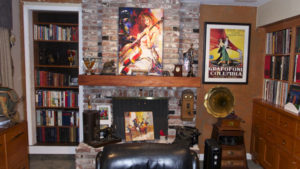
This is the same view of the room as above but with the addition of the sliding bookshelf in the back corner. The white casing will hopefully come off this weekend, and the solid mahogany bookcase shelving will go up. Now the room I hadn’t wanted to change much, has a new floor that absorbs more sound, a ceiling that is more reflective and a corner with a bookcase where there used to be a small table with and an antique German towel rack that held a throw from the San Francisco Symphony. So how did I prepare and adapt to these changes?
Preparing for the Work
I’m not an anal person, but at the same time, I don’t like to listen to music in a place that looks cluttered and has none of my favorite art in it. So, I had to force myself be careful about moving everything. When you have speakers with huge magnets, you need to be sure they won’t be anywhere near the dust and other things in the air during construction. The way I handle this is to wrap the Lowther drivers in Saran wrap and then carefully move the speakers into a closet that has a door I can secure from the dust. Immediately after moving the speakers, I measured the exact placement of the feet on each speaker relative to the rear and side walls. I normally wouldn’t have to do this since marks in the carpet would show where they go, but since the carpet was coming up, I would lose those marks, which made the measurements extremely important. Oh, and one other thing before I forget, I also had to measure the exact placement of my listening chair.
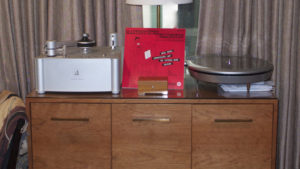
Moving everything else in the room was easy, except for one thing, and it was a bear. That one thing was my Atocha Design of New York solid cherry record cabinet. Since it was delivered by a “white glove” shipping company, I had never had to lift it. I did remember the two delivery guys saying it was really heavy. I emptied out nearly 600 of my favorite LPs and was very careful to keep them in order. This took quite a while, but even when empty, it was too heavy for me to move. Thank goodness the carpet guys could help my son move it. Oh, and for just a few bucks, my 9-year old granddaughter was a big help with moving the albums.
The Setup
The picture below is how my system has been set up for years. Notice the acoustical panels and all the books behind the speakers. I’ve had people insist that my soundstage would be better if I removed all of this. I tried it once, and my system sounded like it was in a cave because of all the echo. Still, I tried to see all of this moving things in and out of the room as an opportunity to fix a few things and try a few new things. I started by putting my Box Furniture Rack on the back wall, centered between the side walls, I had put up with it being an inch and a half off center for nearly eight years; I told you I wasn’t anal. I had also put up with it being a little too close to the rear wall, so I moved it out four inches so I would have more room when changing out components. I decided not to put the books back, so the only thing left was to level the rack and put the equipment back on it.
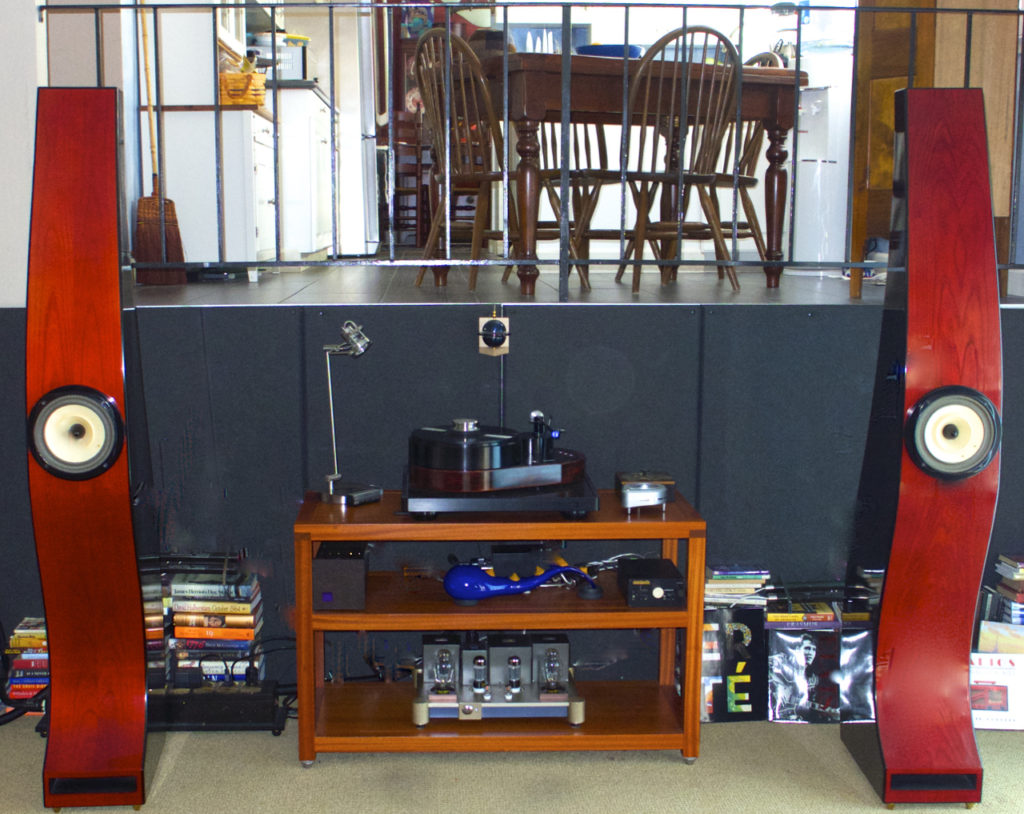
Then I measured where the speakers went and hooked everything back up and let it burn in for a couple of days. During that time, I placed my listening chair back in the same spot and moved in all of the furniture, art and room treatment. The last things I did were to get out the laser tape measure so I could make sure my chair was in the dead center of the room, and I made sure that the toe in for the speakers was just right because you use almost none with Lowthers. So, how did my system sound compared to before?
Getting the listening chair back exactly where it had been was important, but with all of the changes in the room, the question was whether or not the old spot was still the best spot. So, I ran a few tests and played some of the LPs I use to be sure the bass is right. Thankfully, nothing that I’d done to the room had affected where the bass nodes were in the room, so the chair was still in the right spot. Now it was time to listen and see what, if any, the changes to the room had on the sound of my system.
Listening
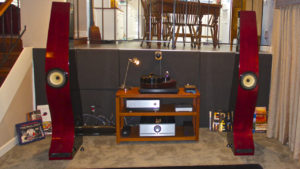
So, did the system sound any different after replacing the carpet, removing the popcorn ceiling and the other changes? Well, yes it did, but if you ask me if it sounded better or worse, my answer would be, yes for the most part. I couldn’t believe that it was more transparent, but it was. The upper midrange and top end were clearer and more extended. The bass was a little warmer and not quite as quick. I was worried that there might be a need to go back to brass spikes on the speakers instead of the Herbie Gliders that I use. The Herbie Gliders allow my Teresonics to have more tone and harmonics than the brass cones.
So the question was how to deal with these changes. I first tried moving the speakers about six inches further out into the room. I had wanted to try this anyway with visions of a deeper and wider soundstage. This was a disaster, it didn’t help the bass, and it caused female vocals to be bright and sibilant. The soundstage didn’t improve either; it was more forward and phasey sounding. So, I put them back and thought a little, I do think about things sometimes. Then I remembered something Jim Smith, the author of Get Better Sound had taught me many years ago, and I think it’s on his setup DVDs as well; the distance between the speakers can affect the sound more than the distance from the rear wall. I also remembered that the footers would need some time to settle into the pile of the new carpet.
The rule of thumb is, if you are close to the distance between the speakers, then the closer you move them to each other the warmer the bass gets. On the other hand, moving them further apart can tighten up the lower-midrange and bass. Now, I’m not talking about moving them a foot further apart or closer together, or not even six inches the first time you move them. I started by moving them each by two inches away from the center line of the room. I went through most of the same cuts I had listened to earlier and thought the sound was better but still not as solid as I would like it to be. I decided it was close enough to let them sit in place so the Herbie Sliders could settle into the carpet from the weight of the speakers.
After they had sat there for the weekend, I listened again and was pleased to discover that the bass was almost back to where it had been before the changes to the room. So, I decided to play around with the books. I discovered that it wasn’t how many books, but where they were placed. I ended up taking some coffee table-size books and rounding out the bottom corners behind the speakers. Now the bass was as good as it ever has been with this system, and the upper-midrange is more open and more extended. So, I decided I would quit while I was ahead.
Writing this article has inspired me to write another article about getting the best out of your system. Keep on bopping’ until then!
